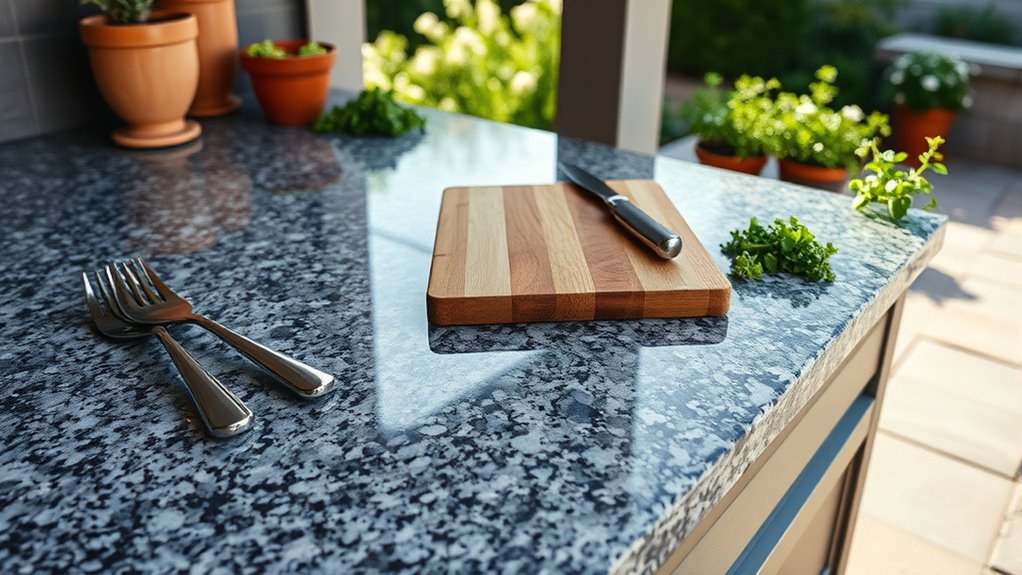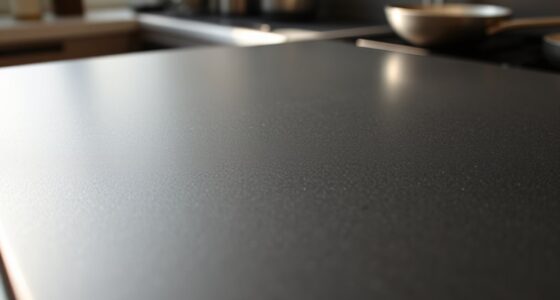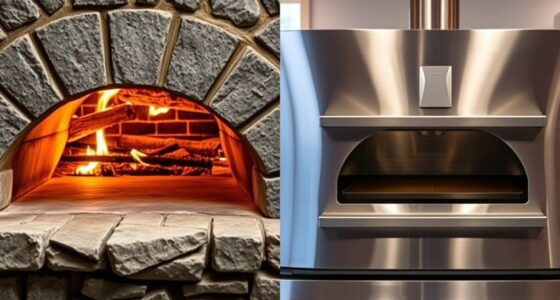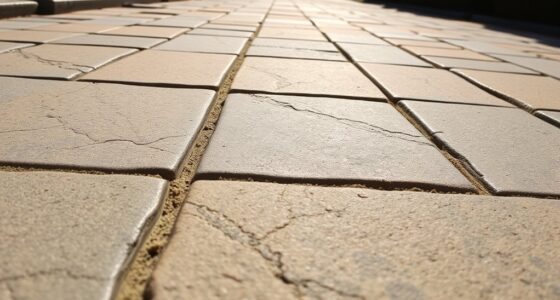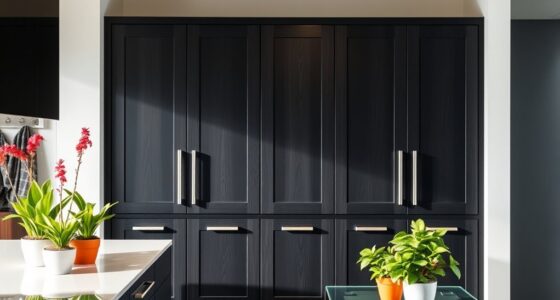Choosing the right outdoor countertop depends on balancing durability, weather resistance, and style. Natural stones like granite are beautiful but need sealing and maintenance, while man-made surfaces like quartz offer better stain resistance and low upkeep. Consider temperature fluctuations, porosity, and your aesthetic preferences. Investing in quality materials pays off long-term, but understanding these factors helps you pick the best fit. Keep exploring to discover detailed tips for making your outdoor space both stunning and resilient.
Key Takeaways
- Natural stone like granite or limestone is durable but requires proper sealing to resist weathering and stains.
- Man-made surfaces such as quartz are highly resistant to moisture, stains, and require minimal maintenance outdoors.
- Consider porosity and sealing needs; less porous materials better resist stains and moisture absorption.
- Choose weatherproof materials that withstand temperature fluctuations, UV exposure, and rain for long-lasting outdoor use.
- Balance initial costs with long-term durability and low maintenance for the best value in outdoor countertop materials.
Natural Stone Options for Outdoor Countertops
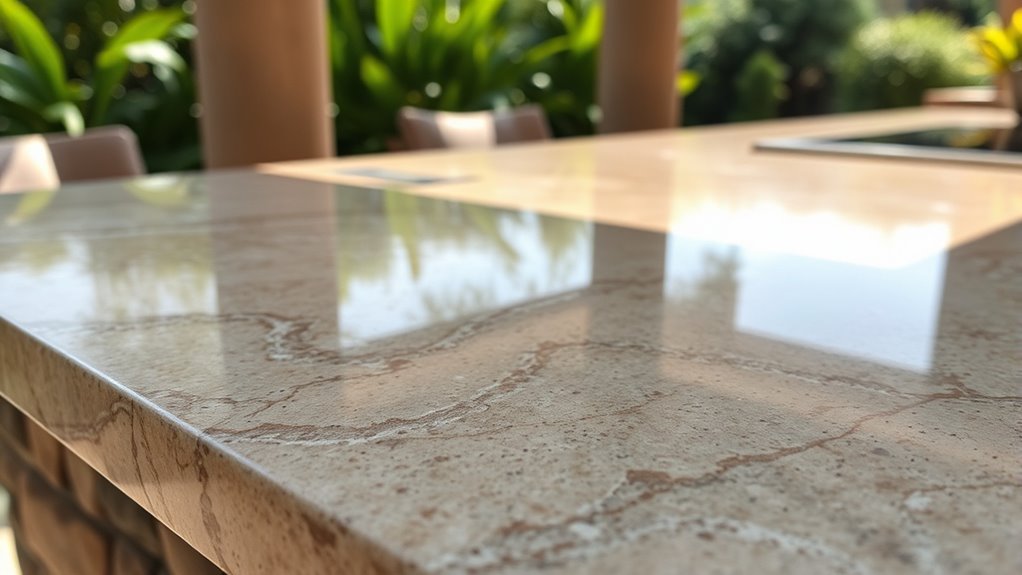
Natural stone is a popular choice for outdoor countertops because of its durability and timeless beauty. However, to keep it looking its best, you need to comprehend sealing techniques. Proper sealing helps protect the stone from moisture, stains, and weather damage. Keep in mind, installation challenges can arise with natural stone, especially due to its weight and irregular surfaces. Precise measurements and skilled installation are essential to prevent cracking or shifting over time. Some stones, like granite or limestone, may require more frequent sealing, while others are more resistant. Additionally, understanding heat pump noise levels can be useful if your outdoor space includes heating or cooling features, ensuring your environment remains comfortable without disturbance. By choosing the right sealing techniques and preparing for installation challenges, you ensure your natural stone countertops maintain their stunning appearance and longevity outdoors.
Man-Made Surfaces: Durability and Maintenance
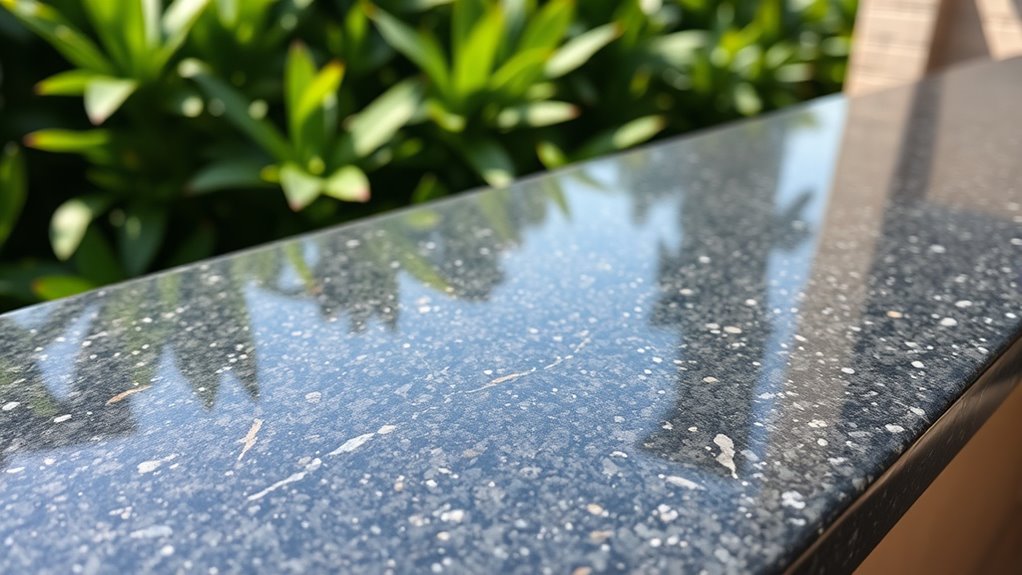
Man-made surfaces have become a popular choice for outdoor countertops because of their impressive durability and low-maintenance requirements. You can keep them looking great with simple cleaning techniques—regularly wiping down with soap and water is usually enough. For tougher stains, use non-abrasive cleaners designed for the specific material. Sealing methods are often unnecessary or minimal, depending on the surface, which saves you time and effort. Unlike natural stone, these surfaces resist staining and scratching better, making them ideal for outdoor use. Just avoid harsh chemicals that could damage the finish. With proper care, man-made surfaces maintain their appearance for years, offering a practical and attractive option that requires less upkeep while standing up to outdoor elements. Additionally, the horsepower of electric dirt bikes demonstrates their power, which can be comparable to traditional gas-powered bikes, making them a reliable choice for off-road adventures.
Temperature Resistance and Weatherproofing
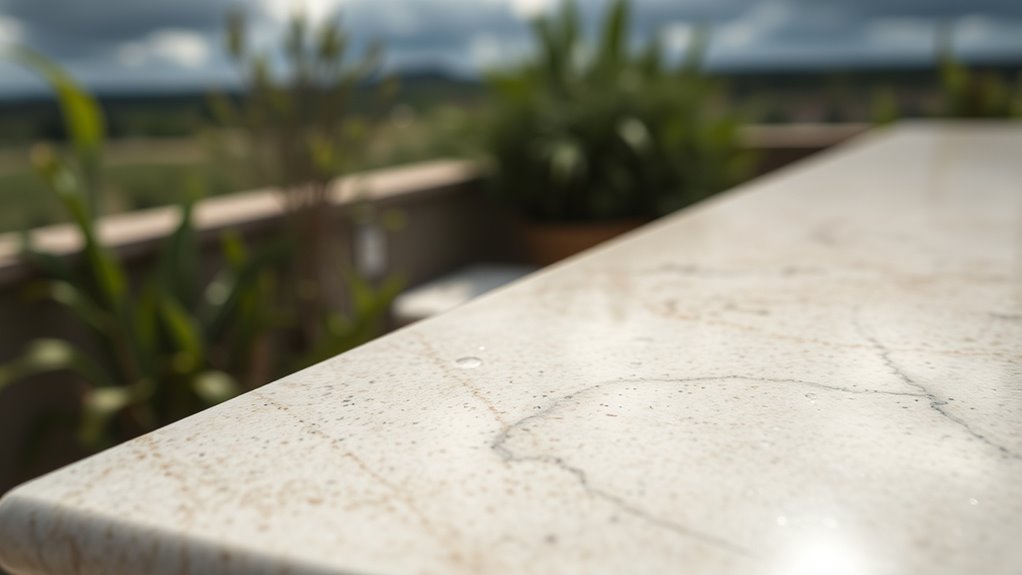
When choosing outdoor countertops, evaluating their temperature resistance and weatherproofing is essential for long-term performance. You need materials that withstand extreme heat, cold, rain, and UV exposure without warping or cracking. Proper installation methods are vital—secure sealing and proper drainage help prevent water damage and weathering. Regular cleaning techniques, like gentle soap and water, keep surfaces free of debris that can trap moisture or cause deterioration. Avoid harsh chemicals that might weaken the material’s weatherproof layers. Materials like natural stone or concrete, when properly sealed, excel in resisting temperature fluctuations and weather conditions. Additionally, selecting materials with inherent weather resistance qualities can further enhance durability. Remember, the right installation and maintenance practices guarantee your countertop remains durable, functional, and attractive over time, saving you money and hassle in the long run.
Porosity and Stain Resistance
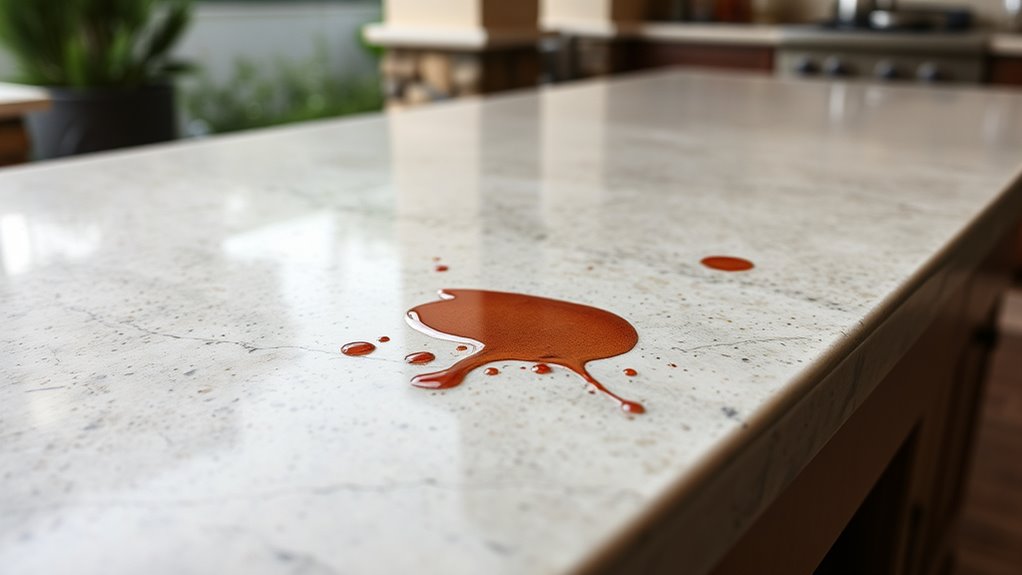
Understanding porosity levels helps you choose the right outdoor countertop material, as it influences how easily stains can penetrate. Some surfaces resist stains better naturally, while others need sealing or treatment. Knowing these strategies ensures your outdoor countertops stay looking their best longer. Additionally, selecting materials with lower porosity levels can reduce the need for frequent maintenance and sealing.
Porosity Levels Explained
Porosity levels play a crucial role in determining how well a countertop material resists stains and absorbs liquids. Higher porosity means the material can absorb more moisture, increasing the risk of stains and damage. To combat this, sealing techniques are essential; they create a barrier that reduces moisture absorption and helps maintain the surface’s appearance. Materials like natural stone, such as granite or marble, tend to be more porous, requiring regular sealing to protect against spills and weather exposure. Conversely, man-made surfaces like quartz are less porous and naturally resist moisture. Understanding porosity levels helps you choose the right material and maintain it properly. Proper sealing prolongs the lifespan of your outdoor countertop and keeps it looking its best, regardless of porosity. Additionally, filtration technology in air purifiers can effectively remove airborne contaminants, further supporting outdoor environments by reducing pollutants and allergens nearby.
Stain Resistance Strategies
Since porosity directly affects how susceptible a countertop is to stains, implementing effective stain resistance strategies is essential for outdoor surfaces. One key approach is using sealing techniques to minimize porosity, creating a barrier that prevents liquids from seeping in and causing stains. Regular sealing, especially for natural stone, keeps the surface less vulnerable over time. Along with sealing, establishing consistent cleaning routines helps remove spills and dirt before they penetrate the material. Use gentle, pH-neutral cleaners suited for your countertop type, and avoid harsh chemicals that can damage the sealant. By combining proper sealing techniques with diligent cleaning routines, you markedly enhance your countertop’s stain resistance, ensuring it remains attractive and durable despite outdoor exposure. Additionally, understanding the 16PF traits of your material can help you select the most suitable protective measures for longevity and performance.
Aesthetic Flexibility and Design Considerations
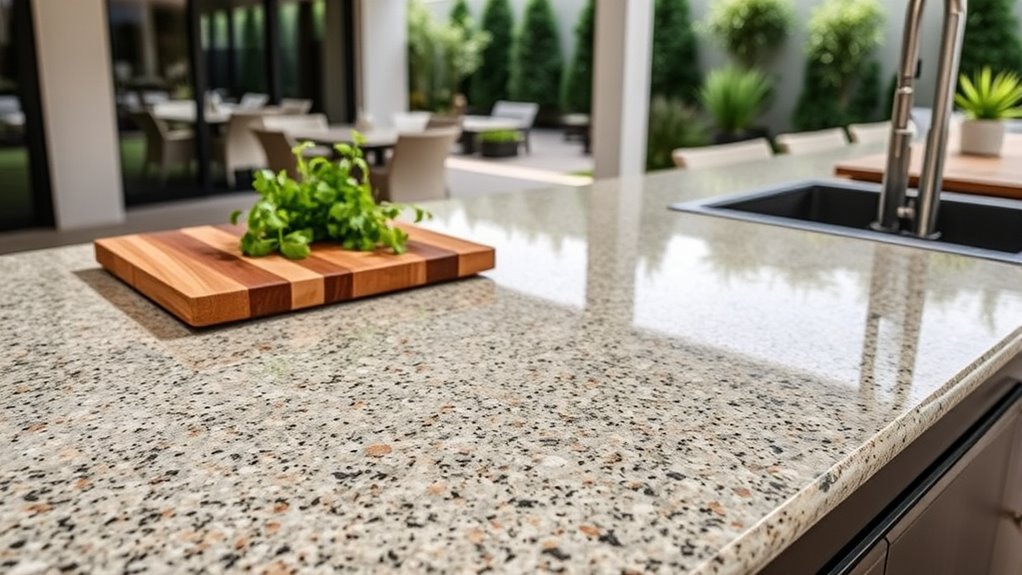
Your outdoor space benefits from countertop materials that match your style and vision. You can choose from various options that complement existing design elements and create a cohesive look. With a wide range of colors and patterns, you’ll find the perfect aesthetic to enhance your outdoor area. Incorporating creative design ideas can further elevate the overall appeal and ensure your outdoor countertops reflect your unique personality.
Style Compatibility Options
When selecting outdoor countertop materials, considering style compatibility guarantees your space reflects your personal aesthetic while maintaining harmony with existing design elements. You want your countertops to blend seamlessly with your outdoor decor, whether you prefer modern, rustic, or traditional styles. Think about the material’s texture, finish, and overall vibe. For example, sleek quartz fits contemporary spaces, while natural stone complements rustic settings. Proper sealing techniques are essential to preserve the look and durability of your chosen surface. Also, follow installation tips that ensure the material’s integrity and aesthetic appeal. By matching your material choice to your design theme and applying the right sealing and installation methods, you create a cohesive, stylish outdoor area that feels uniquely yours. Additionally, choosing materials that align with sustainable practices can enhance the environmental friendliness of your outdoor space.
Color and Pattern Choices
Choosing the right color and pattern for your outdoor countertops offers you incredible flexibility to enhance your space’s overall look. With thoughtful color matching, you can create a seamless flow or a bold contrast that highlights your design. Pattern variety allows you to add visual interest, whether you prefer subtle veining or striking geometric designs. Lighter shades can make a small area feel more open, while darker colors add sophistication and depth. Mixing patterns carefully can elevate your aesthetic without overwhelming the space. Keep in mind that the pattern complexity and color palette should complement your existing outdoor elements. Additionally, selecting durable countertop materials ensures your design remains functional and stylish over time. By considering these factors, you guarantee your countertops become a cohesive, stylish feature that reflects your personal taste.
Cost Factors and Long-Term Value

While some countertop materials may have a higher upfront cost, they often offer greater long-term value through durability and low maintenance. Conducting a thorough pricing analysis helps you understand the true expense over time, factoring in durability and upkeep. For example, materials like natural stone or composite tend to have higher installation costs but withstand outdoor elements better, reducing repair and replacement needs. Cheaper options might save you money initially but could require frequent repairs or replacements, increasing costs down the line. When evaluating options, consider the balance between initial expenses and long-term savings. Investing in a durable, low-maintenance material can save you money and effort over the years, making it a smarter, more cost-effective choice. Additionally, understanding the aromatic properties of certain materials can enhance outdoor spaces by creating a pleasant environment.
Tips for Selecting the Best Material for Your Space
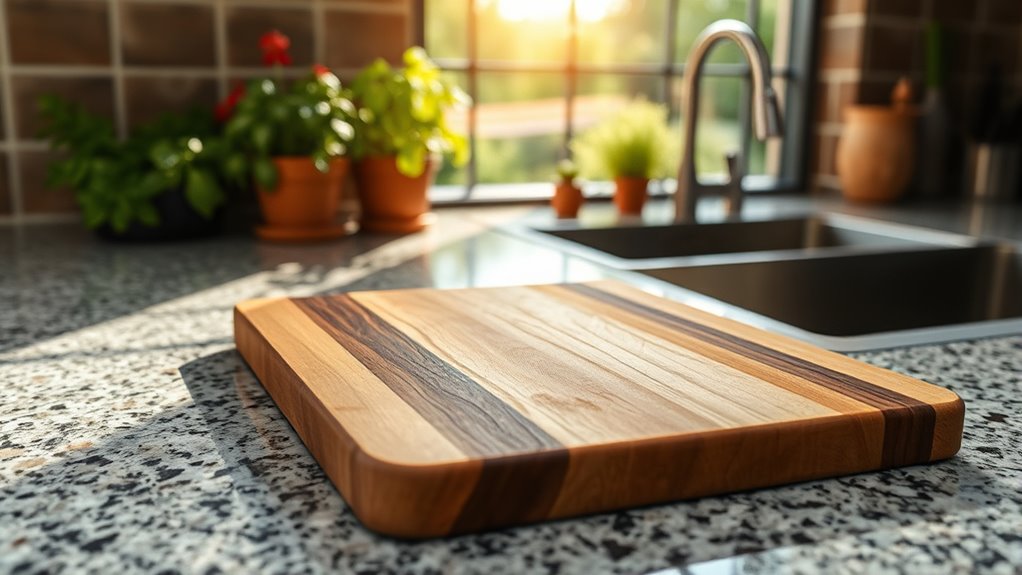
To select the best material for your outdoor space, start by evaluating your specific needs and how you plan to use the countertop. Consider factors like durability, maintenance, and aesthetics. Think about your outdoor lighting setup—will the surface be visible at night? Also, determine if privacy screens are needed to create a secluded feel, influencing your choice of material. For example, natural stone works well with ambient lighting, while composite options offer low maintenance for busy areas. Use this table to guide your decision:
| Use Case | Material Preference | Additional Features |
|---|---|---|
| Entertaining at night | Light-reflective surfaces | Enhance with outdoor lighting |
| Creating privacy | Opaque, durable materials | Complement privacy screens |
| Daily outdoor prep | Resistant to weathering | Low maintenance options |
Choose based on how your space functions best.
Frequently Asked Questions
Which Outdoor Countertop Materials Are Most Eco-Friendly?
You should choose outdoor countertop materials with recycled content or biodegradable options for eco-friendliness. Recycled materials like reclaimed wood, glass, or composite surfaces reduce waste and conserve resources. Biodegradable options, such as bamboo or cork, break down naturally and have minimal environmental impact. These choices help you create a sustainable outdoor space while supporting eco-conscious practices, making your outdoor countertops both stylish and environmentally responsible.
How Do UV Rays Affect Different Countertop Surfaces Over Time?
You might find that UV rays gently nudge your outdoor countertops over time, leading to subtle surface discoloration and UV degradation. Different materials respond uniquely; for example, natural stone may fade, while composite surfaces hold up better. To keep your space vibrant, consider choosing UV-resistant materials or applying protective sealants. Regular maintenance helps slow aging, ensuring your outdoor countertop remains beautiful and functional for years to come.
Are There Specific Materials Better Suited for High-Traffic Outdoor Kitchens?
For high-traffic outdoor kitchens, you should choose durable materials like granite or concrete, as they handle wear and tear well. These surfaces require minimal maintenance and resist scratches, stains, and UV damage. Avoid softer stones like marble, which may chip or stain easily. Prioritize materials with high durability considerations to guarantee your countertops stay functional and attractive over time, even with frequent use.
Can Certain Materials Withstand Saltwater or Coastal Environments?
If you want your outdoor countertops to survive the relentless saltwater and coastal environment, you need materials with incredible saltwater durability and coastal environment resilience. Think superhuman strength against corrosion, rust, and fading. Materials like granite or certain engineered stones are your best bets—they’re built to withstand the harshest seaside conditions, keeping your outdoor space looking stunning for years. Don’t settle for less; choose materials that conquer the coast!
What Are the Best Options for DIY Outdoor Countertop Installations?
For DIY outdoor countertops, opt for cost-effective materials like concrete, which is versatile and durable with proper sealing. Use DIY installation tips such as creating a sturdy frame, leveling the surface, and sealing edges to prevent water damage. Consider lightweight options like tile or composite materials if ease of handling matters. Always prep your space thoroughly, follow manufacturer instructions, and prioritize sealing to extend your countertop’s lifespan outdoors.
Conclusion
Choosing the right outdoor countertop isn’t just about looks — it’s about durability, weather resistance, and value. Each material has its secrets, and what works for one space might not suit another. Ready to make a decision? Keep these insights in mind, but remember, the best choice might surprise you. The perfect countertop is waiting just around the corner — are you prepared to discover it?
